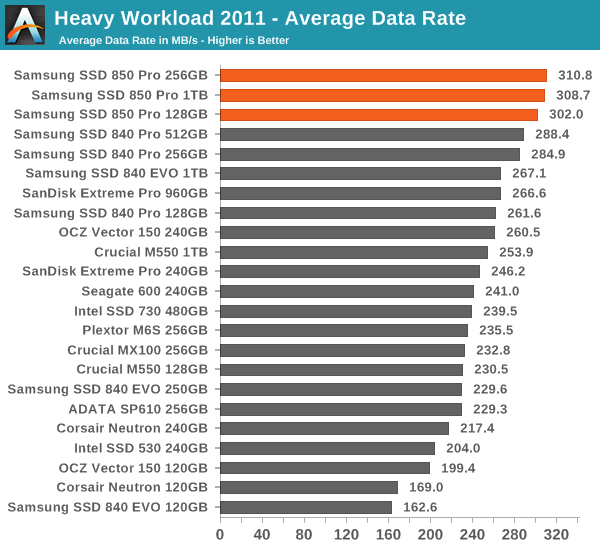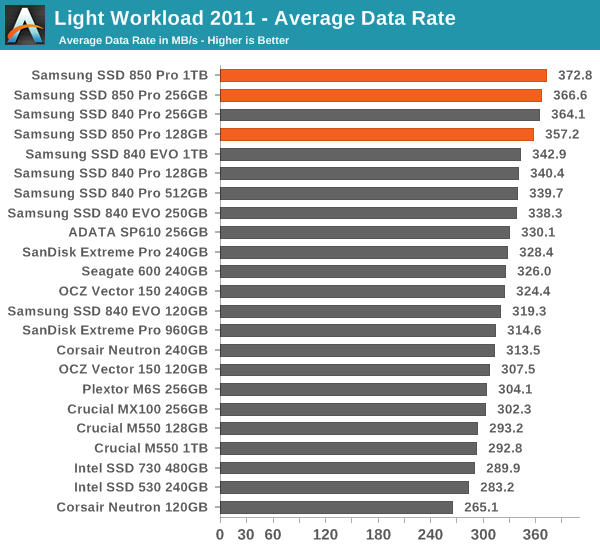Samsung SSD 850 Pro (128GB, 256GB & 1TB) Review: Enter the 3D Era
by Kristian Vättö on July 1, 2014 10:00 AM ESTAnandTech Storage Bench 2011
Back in 2011 (which seems like so long ago now!), we introduced our AnandTech Storage Bench, a suite of benchmarks that took traces of real OS/application usage and played them back in a repeatable manner. The MOASB, officially called AnandTech Storage Bench 2011 - Heavy Workload, mainly focuses on peak IO performance and basic garbage collection routines. There is a lot of downloading and application installing that happens during the course of this test. Our thinking was that it's during application installs, file copies, downloading and multitasking with all of this that you can really notice performance differences between drives. The full description of the Heavy test can be found here, while the Light workload details are here.

The dominance continues in our 2011 Storage Benches. The 840 Pro was already the fastest drive in both suites, so it does not come as a surprise that the 850 Pro takes the lead.











160 Comments
View All Comments
frenchy_2001 - Tuesday, July 1, 2014 - link
the 3D structure and design are revolutionary, but the manufacturing technology is actually a very mature one (40nm). This makes it *MUCH* cheaper than the 1X used by their competition.Samsung has really struck gold with that design, as it allows them to scale in both dimensions, depending on the result and cost of each. While 2D NAND is facing really tough challenges to increase density, V-NAND is allowed to either scale up (more layers) or restart scaling pitch, as manufacturing is *very well* understood from 40nm->~16nm. They just need to experiment with it and see what makes economic sense and good trade-offs.
toyotabedzrock - Tuesday, July 1, 2014 - link
Almost seems like it would be cheaper to ramp up the production of silicon ingots and drive that cost down further than the r&d for this.frenchy_2001 - Tuesday, July 1, 2014 - link
Silicon ingots cost is marginal. The real cost for scaling is all the R&D necessary to make the pitch smaller. Even using bigger wafers (current ones are 300mm, there have been talks of 450mm for a while, but cost is a deterrent, as a whole fab needs to be re-tooled for the upgrade) only improves yields and costs marginally.NAND scaling down is facing huge challenges, due both to process (who to image those ~15nm line on a wafer) and electrical limits (~3 electrons inside your cell at 15nm). 3D NAND allows to restart the growth by bypassing those challenges (step back to 40nm process and scale in the Z axis).
General SOCs are facing similar process limits (there is no solution below 10nm so far, despite the whole industry cooperating to find one), even if their design limits are more relaxed (SOCs are not trapping charges, but cross talk and interference are starting to be challenges too).
UltraWide - Monday, June 30, 2014 - link
Will there be a version with PCIe or M.2?Gigaplex - Monday, June 30, 2014 - link
If you'd read the article, you'd know the controller doesn't support PCIe.Gigaplex - Monday, June 30, 2014 - link
"This further suggests that the issue lies in our tests instead of the RAPID software itself as end-users will always run the drive with a partition anyway."Um, no. I don't care what the end user does, the software shouldn't cause a BSOD. If it can't cache without a partition, it should simply not attempt to cache. This is just a case of Samsung thinking that just because they do some nice hardware, that they're experts in software. They're really not. RAM caching of I/O isn't specific to SSDs anyway, why are they tying it to an SSD launch?
Donuts123 - Wednesday, July 2, 2014 - link
Yeah, that's a huge red flag for me, I definitely wouldn't use the RAPID software. Another layer to go wrong (and apparently it does). I hope Anandtech submits details of the BSODs they saw to Samsung.RAPID probably just uses the Samsung SSD as a dongle. Presumably RAPID is derived from Samsung's acquisition of NVELO, see http://www.anandtech.com/show/6518/samsung-acquire...
Guspaz - Monday, June 30, 2014 - link
Wait a minute, 150TB endurance on a 1TB drive? Only 150 cycles? That doesn't make any sense, that's absurdly low.Then again, Intel's rating for the 335 doesn't make any sense either. They say 20GB a day for 3 years, or about 22TB... But they also rate it for 3000 cycles, and the media wear indicator on the drive is set to treat 3000 as full wear, and that represents 720TB...
Kristian Vättö - Tuesday, July 1, 2014 - link
The endurance figures are usually based on a 4KB random write workload and are thus worst-case numbers. 150TB of random writes means a ton of more NAND writes than 150TB, that's why. I explained the calculation of TBW here:http://www.anandtech.com/show/7947/micron-m500-dc-...
However, as I mentioned in the article, in the client space the endurance is more for guidance (i.e. don't put these in servers!) than an actual technical limit.
emn13 - Tuesday, July 1, 2014 - link
...but outside of server-like workloads, what's going to benefit from this performance?